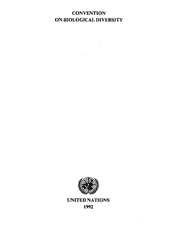Convention on Biological Diversity (CBD)
The Convention on Biological Diversity (CBD) governs international efforts to conserve biological diversity, and ensure an equitable distribution of the benefits arising from genetic resources. The treaty recognizes member states’ sovereignty over their natural resources, including genetic material (Art. 15), which has proved controversial when exercised over pathogens. There are two protocols to the Convention on Biological Diversity: the Cartagena Protocol, which governs the handling and transport of living modified organisms (LMOs), and the Nagoya Protocol, which governs the equitable distribution of benefits arising from a country’s genetic resources.
| Opened for signature | 5 Jun 1992 | ||||||||||||
| Entered into force | 29 Dec 1993 | ||||||||||||
| Latest update | 4 Jun 1992 | ||||||||||||
| Available languages |
|
Related treaties
States parties
Countries automatically become a party to the Convention on Biological Diversity 90 days after depositing their instrument of ratification, acceptance, approval or accession. Download the data in this table to view any reservations, understandings, and declarations (RUDs).
Country | Status | Signed | Ratified | Entered into force |
|---|---|---|---|---|
| Afghanistan | Party | 12 Jun 1992 | 19 Sep 2002 | 18 Dec 2002 |
| Albania | Party | 5 Jan 1994 | 5 Apr 1994 | |
| Algeria | Party | 13 Jun 1992 | 14 Aug 1995 | 12 Nov 1995 |
| Andorra | Party | 4 Feb 2015 | 5 May 2015 | |
| Angola | Party | 12 Jun 1992 | 1 Apr 1998 | 30 Jun 1998 |
| Antigua and Barbuda | Party | 5 Jun 1992 | 9 Mar 1993 | 29 Dec 1993 |
| Argentina | Party | 12 Jun 1992 | 22 Nov 1994 | 20 Feb 1995 |
| Armenia | Party | 13 Jun 1992 | 14 May 1993 | 29 Dec 1993 |
| Australia | Party | 5 Jun 1992 | 18 Jun 1993 | 29 Dec 1993 |
| Austria | Party | 13 Jun 1992 | 18 Aug 1994 | 16 Nov 1994 |
Party
The state has accepted, approved, ratified, or is otherwise party to the agreement, indicating consent to be bound to the agreement.
Signatory
The state has signed, but not yet ratified or become an official party to the agreement. Where the signature is subject to ratification, acceptance or approval, the signature does not establish the consent to be bound. However, it is a means of authentication and expresses the willingness of the signatory state to continue the treaty-making process. The signature qualifies the signatory state to proceed to ratification, acceptance or approval. It also creates an obligation to refrain, in good faith, from acts that would defeat the object and the purpose of the agreement.
Non-party
The state has not taken any actions with regard to the agreement.
Associate member
The state may have requirements for some of the statutory or non statutory aspects of an agreement, but would not confer all of the obligations of the agreement on the member. Associate members may not have voting rights.
Observer
The state is non-party to an agreement, but has the ability to attend meetings or other discussions, and otherwise participate in activities. Observers may be granted permission to speak at formal meetings.




